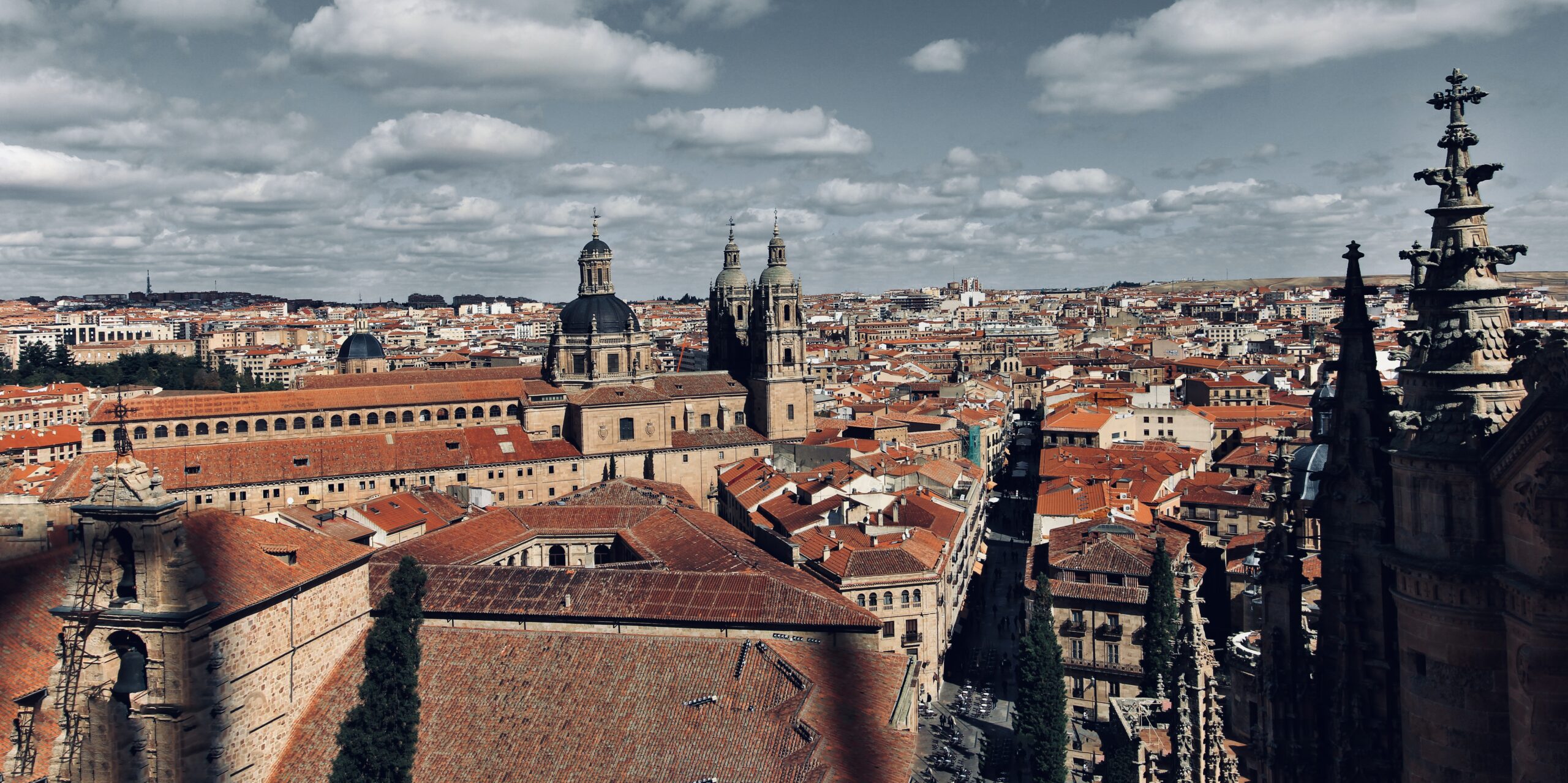Gazing upon the enchanting panorama of Salamanca, one is immediately captivated by a tapestry of terracotta rooftops, centuries-old cathedrals, and a horizon that whispers tales of an illustrious past. Salamanca, nestled in the heart of Spain’s Castile and León region, presents an extraordinary blend of history, culture, and architectural splendor, all set against a backdrop that evokes the timeless charm of the Spanish countryside. This city, with its warm-hued buildings and majestic towers, seems almost frozen in a golden era, untouched by the hustle and bustle that characterizes more tourist-heavy destinations.

A significant feature in the panorama is the imposing presence of the New Cathedral, with its Gothic and Baroque elements reaching skyward. Built between the 16th and 18th centuries, this architectural masterpiece stands as a testament to the city’s rich historical tapestry. Adjacent to it, the Old Cathedral, with its Romanesque style, offers a poignant contrast, showcasing the evolution of ecclesiastical architecture through the ages. The intricate spires, domes, and ornate carvings of these structures invite the viewer to delve deeper into the stories etched into every stone and gargoyle.
Wandering through the city’s labyrinthine streets reveals a treasure trove of hidden gems, each with its own unique charm and allure. The University of Salamanca, founded in 1218, is one such jewel, renowned as one of the oldest universities in Europe. Its Plateresque façade, adorned with carvings and reliefs, captures the essence of Spanish Renaissance art. The university’s historic classrooms and libraries, echoing with the whispers of scholars and luminaries such as Miguel de Cervantes, offer a glimpse into the intellectual heritage that has shaped the modern world.
But beyond these well-known landmarks, Salamanca’s true magic lies in its lesser-known corners and quiet, unfrequented spots. The Casa de las Conchas, for instance, is a stunning building decorated with over 300 carved scallop shells, each symbolizing the pilgrimage to Santiago de Compostela. This historic mansion now serves as a public library, where the serenity and quietude provide a stark yet inviting contrast to the lively Plaza Mayor nearby.
The Convento de San Esteban, another hidden marvel, is a Dominican monastery with a striking Plateresque façade that often goes unnoticed by hurried tourists. The cloisters and chapels within are havens of tranquility, their silence broken only by the soft murmur of prayers and the rustle of ancient manuscripts. Nearby, the Cueva de Salamanca, a mysterious cave steeped in legend and folklore, is said to have been a school of black magic attended by the devil himself. This eerie yet fascinating site adds an element of intrigue and mysticism to the city’s cultural narrative.
For those seeking a more intimate experience of Salamanca’s rich history, the Huerto de Calixto y Melibea offers a secluded garden retreat, perfect for a leisurely stroll or quiet reflection. Overlooking the ancient Roman Bridge and the serene River Tormes, this romantic garden is believed to be the setting for the tragic love story of Calixto and Melibea, immortalized in the Spanish literary classic “La Celestina.” The garden’s lush greenery and fragrant blooms provide a soothing escape from the city’s bustling plazas and thoroughfares.
Food enthusiasts will find Salamanca’s culinary scene to be a delightful exploration of traditional Spanish flavors and innovative gastronomy. Tucked away in the narrow streets, away from the main tourist routes, are family-run tapas bars and quaint eateries offering regional specialties such as hornazo, a savory pastry filled with pork, chorizo, and hard-boiled eggs. The Mercado Central, with its vibrant stalls brimming with fresh produce, local cheeses, and cured meats, is a sensory feast that showcases the region’s rich agricultural heritage.
Despite its many attractions, Salamanca remains relatively unspoiled by the throngs of tourists that descend upon Spain’s more famous cities. This allows for a more authentic and immersive experience, where one can truly connect with the local culture and history. The city’s proximity to the Portuguese border further enhances its appeal, offering opportunities for cross-border excursions to explore the charming towns and scenic landscapes of Portugal. The nearby Arribes del Duero Natural Park, with its dramatic cliffs and picturesque vineyards, is a must-visit for nature lovers and adventure seekers alike.
As the sun sets over Salamanca, casting a warm, golden glow over its historic skyline, the city takes on an almost magical quality. The streets, bathed in the soft light of lanterns, invite evening strolls and the chance to uncover yet more hidden gems. The lively buzz of tapas bars, the distant strumming of a guitar, and the laughter of locals enjoying the evening air create an atmosphere that is both enchanting and deeply inviting.
In conclusion, Salamanca is a city that offers far more than meets the eye. Its well-preserved historical sites and renowned landmarks are just the beginning. The true essence of Salamanca lies in its hidden gems, its quiet corners, and its rich tapestry of stories waiting to be discovered. It is a place where history and modernity coexist harmoniously, where every street and building has a tale to tell. For the discerning traveler, Salamanca promises an experience that is both profound and unforgettable, a journey into the heart of Spain’s cultural and historical heritage, unspoiled by the trappings of mass tourism. So pack your bags, set your sights on Salamanca, and prepare to uncover the myriad treasures of this extraordinary city.
Leave a Reply